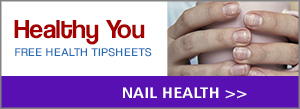They might not be the most attractive part of your body, but your feet are real workhorses. In fact, the American Podiatric Medical Association calls them “biological masterpieces.”
Okay, we’re not fooling anyone here. Your feet don’t always look or feel like masterpieces. Sometimes, they might even feel like throbbing stumps glued to your ankles.
But there are good reasons to treat those tootsies with respect. According to the American Academy of Orthopaedic Surgeons, every mile you walk puts 60 tons of stress on each foot. Consider this: There are 26 bones and 33 joints in each of your feet, which together are home to 25 percent of all your body’s bones. Each foot contains a complex system of more than 100 tendons, muscles, ligaments, blood vessels and nerves. Not to mention sweat glands — 250,000 of them in each of the little stinkers.
Your feet are the furthest part of your body from your eyes, but keeping them healthy starts with your eyes and ears, says Janet E. Simon, DPM, spokesperson for the American Podiatric Medical Association.
“Look, listen and feel, if you can,” she advises. “Look for any changes in the skin, any areas of blisters, discolorations or injuries. Listen to what your body is telling you.”
There are basic, easy things you can do to take care of your feet, and foot pain is not normal.

Photos and art courtesy iStockphoto
“If you have foot pain, it needs to be evaluated by a health care professional,” she says. “Don’t wait until your feet hurt to pay attention to them.”
Your feet can mirror other health problems, so don’t ignore foot ailments, which are among the most common health problems in America. And don’t just blame foot problems on your genes. To keep your feet healthy, learn about the most common issues that can keep you from putting your best foot forward.
These shoes are made for walking
By the time you’re 50 years old, your feet will have logged about 75,000 miles, but are those three-inch spiked heels good for your feet?
Some of the biggest threats to foot health are women’s dress shoes, Simon says.
“We all know that we are not going to do away with fashion,” she says. “But we generally suggest that the heel should probably not be higher than an inch and one-half to two inches, and it should be a square heel, not spikes.”
Tight shoes with narrow “toe boxes” — the front end of the shoe that provides space for the toes — along with high heels are especially bad. Look for shoes with toe boxes that are more square or rounded, rather than those that are severely tapered, Simon says.
Over time, toes that are squeezed can worsen a condition known as “hammertoe,” which means the toes draw up and begin looking like little claws or hammers. Poorly fitted shoes can also cause bunions, calluses and corns.
A step in the right direction
Diabetes, which now affects about 23 million Americans, and certain other medical conditions can cause special foot care problems. Nerve damage, circulation problems and infections can cause serious issues for people with diabetes. In fact, more hospital bed days are spent treating diabetic foot problems than all other diabetic conditions.
If you’re diabetic, inspect your feet daily, or have someone else look at them if you can’t. Have your feet checked regularly by a health professional, and get your shoes professionally fitted.
“Poorly fitting shoes can be a problem, and many diabetics, as they lose the feeling in their feet, often cannot tell if the shoe is rubbing or causing blisters, which can lead to infection,” Simon says.

This little piggy went to market
Pedicures are good for your feet, so don’t feel guilty about getting your piggies pampered, provided you’re in good health. To reduce the risk of fungus or other infections, purchase your own nail implements and take them with you when you go to the salon.
If you have diabetes, poor circulation in your feet or other health conditions that would put you at risk, professional foot care from a trained health professional, such as a podiatrist, is recommended.
Get the facts on the flops
The all-American flip-flop can be a happy sign of summer and a good way to protect your feet at the beach or in a locker room shower. But too much flip-flopping can be bad for your hoofers.

Flip-flops were designed for the beach as protection from the hot sand, says Janet E. Simon of the American Podiatric Medical Association, “but now people are using them on hard, concrete surfaces all the time, and that does not support the foot structure.”
Toward the end of summer and fall, many health professionals see an increase in heel and tendonitis complaints linked to the overuse of flip-flops and other nonsupportive sandals, she says.
>> For more foot health tips, visit www.apma.org or www.nlm.nih.gov/medlineplus/foothealth.html
- Copyright The Nation’s Health, American Public Health Association








